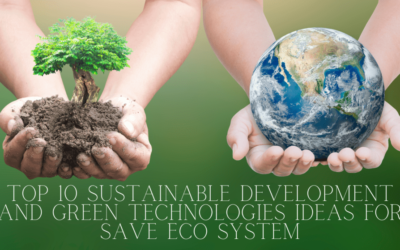In an era where the planet is facing unprecedented environmental challenges, technological innovations are emerging as potent tools to reverse the damage and protect our fragile ecosystem. The convergence of science, engineering, and sustainability has paved the way for a wide range of solutions that hold the promise of safeguarding our natural world. From reimagining energy production to transforming waste management, the potential of technology to save the ecosystem is immense. In this blog post, we delve into some of the groundbreaking ways technology is being harnessed to drive ecological conservation and sustainability.
Renewable Energy Revolution
One of the most significant contributions technology has made to the ecosystem is in the realm of renewable energy. Solar panels, wind turbines, and hydroelectric systems have become synonymous with clean energy generation. These innovations have not only reduced our reliance on fossil fuels but also significantly lowered greenhouse gas emissions. Advanced photovoltaic cells are more efficient than ever, capturing sunlight to produce electricity even in low-light conditions. Wind turbines, designed using sophisticated aerodynamics, harness wind energy with minimal impact on local ecosystems. Moreover, emerging technologies like tidal and geothermal energy are tapping into previously untapped resources, further diversifying our energy portfolio. There is an amazing luxury spa in Toronto that uses renewable energy if you want to visit it.
Smart Grids and Energy Efficiency
The development of smart grid technology has transformed the way energy is distributed and consumed. Smart grids enable real-time monitoring of energy usage, allowing for efficient load balancing and reducing wastage. This technology empowers consumers with insights into their energy consumption patterns, encouraging them to make informed choices about when and how they use electricity. Additionally, smart appliances and home automation systems contribute to energy efficiency by adjusting energy consumption based on demand and availability. If you want to rent energy energy-efficient vehicle to travel through the country check out Explorer RV in Key West.
Precision Agriculture
Modern agriculture has often been criticized for its negative impact on the environment, including excessive water usage and pesticide runoff. However, technology is coming to the rescue with the advent of precision agriculture. Through the integration of sensors, drones, and data analytics, farmers can now optimize irrigation, monitor soil health, and precisely apply fertilizers and pesticides only where needed. This not only conserves resources but also minimizes environmental pollution. This transformation of agriculture into a more sustainable and efficient tapestry holds promise for a greener future.
Biodiversity Monitoring and Conservation

Technological advancements are also playing a pivotal role in biodiversity conservation. Remote sensing technologies like satellite imagery provide scientists with valuable insights into changes in land cover, deforestation, and habitat loss. Coupled with machine learning algorithms, these tools help in identifying critical areas for conservation efforts. Furthermore, camera traps and acoustic sensors enable the monitoring of elusive and nocturnal species without human interference, contributing to a better understanding of wildlife behaviors and habitats.
Waste Management and Recycling
The growing concern over waste accumulation and plastic pollution has prompted the development of innovative waste management solutions. Advanced recycling technologies can transform plastic waste into valuable resources, reducing the strain on landfills and the environment. Moreover, waste-to-energy technologies can convert organic waste into biogas or electricity, providing a sustainable alternative to traditional waste disposal methods. In our pursuit of sustainable waste management, tools like a career match quiz can help individuals find meaningful roles in this crucial field.
Ocean and Waterbody Protection
The world’s oceans are facing numerous challenges, from overfishing to plastic pollution and coral reef degradation. Technology is stepping in with underwater drones and remotely operated vehicles (ROVs) that enable researchers to explore and monitor marine ecosystems in unprecedented detail. These tools aid in coral reef restoration, invasive species management, and the mapping of underwater habitats, contributing to the preservation of marine biodiversity.
Urban Green Initiatives
As urbanization continues to accelerate, the need for green spaces in cities becomes even more critical. Urban planners are turning to technology to design and implement green infrastructure. Vertical gardens, rooftop solar installations, and smart irrigation systems are transforming concrete jungles into more sustainable and livable environments. Additionally, apps and platforms that promote carpooling, bike-sharing, and public transportation help reduce carbon emissions in urban areas.
Sustainable Transportation
The transportation sector has long been a significant contributor to air pollution and greenhouse gas emissions. However, technology is revolutionizing the way we move people and goods, with a strong focus on reducing the environmental footprint. Electric vehicles (EVs) have gained substantial traction, offering a cleaner alternative to traditional internal combustion engine vehicles. Advances in battery technology have extended EV ranges and reduced charging times, making them more practical for everyday use. Additionally, the development of hydrogen fuel cell vehicles presents another avenue for sustainable transportation, emitting only water vapor as a byproduct.
If you have a problem with transmission in your electric car you can visit transmission repair in Cheektowaga.
Carbon Capture and Sequestration

While the shift towards renewable energy is crucial, addressing the existing carbon dioxide levels in the atmosphere is equally important. Carbon capture and sequestration (CCS) technologies aim to capture CO2 emissions from industrial processes and power plants, preventing them from entering the atmosphere. This captured carbon can then be stored underground in geological formations, effectively reducing carbon emissions. The continuous advancement of CCS technology holds the potential for substantial progress in combating climate change. If you want to help reduce carbon emissions you should drive electric vehicles. Try out vehicles from rent a car Beograd to choose which one would you like for yourself.
Artificial Intelligence in Conservation
Artificial intelligence (AI) is not only transforming industries but also making a significant impact on ecological conservation. Machine learning algorithms can analyze vast amounts of ecological data, enabling researchers to detect patterns and make informed decisions about conservation strategies. AI-powered predictive models can help predict species distribution changes due to climate change, facilitating proactive conservation efforts. Moreover, AI-driven automated species identification tools aid in monitoring and tracking endangered species, streamlining the conservation process. If you want to learn more about AI you can enroll in online courses.
Circular Economy and Sustainable Design
The traditional linear economy model of “take, make, dispose” has led to resource depletion and environmental degradation. The concept of a circular economy is gaining traction, emphasizing the reuse, repair, and recycling of products to minimize waste and resource consumption. Technology plays a pivotal role in enabling this transition by promoting sustainable design practices, developing materials with reduced environmental impact, and facilitating the creation of closed-loop systems that keep products and materials in circulation for longer.
Space Technology for Earth Observation
Space technology has transcended its celestial applications and is now being harnessed for understanding and protecting Earth’s ecosystems. Satellites equipped with advanced sensors provide a global perspective on environmental changes, including deforestation, ice melt, and urban expansion. This real-time data is invaluable for policymakers, conservationists, and researchers, enabling them to make informed decisions and take timely action to mitigate ecological challenges.
Social Awareness and Tech-Driven Education

Technology’s impact extends beyond physical solutions; it also shapes social consciousness and fosters education. Social media platforms enable environmental advocates to spread awareness, mobilize communities, and drive conservation initiatives. Virtual reality and augmented reality applications transport users to immersive experiences that showcase the beauty and fragility of our ecosystems, inspiring empathy and understanding. Online platforms also offer courses and resources that empower individuals to learn about sustainability and adopt eco-friendly practices in their daily lives.
Collaborative Platforms for Global Impact
Technology has made the world more interconnected than ever before. Collaborative platforms and online communities facilitate the exchange of ideas, research findings, and best practices among experts, organizations, and individuals across the globe. This interconnectedness accelerates the spread of innovative solutions, fosters cross-disciplinary collaborations, and amplifies the impact of ecological conservation efforts.
Adapting to a Changing Climate
Climate change is a defining challenge of our time, and technology is indispensable in both mitigating its impacts and adapting to its consequences. Advanced weather forecasting models help communities prepare for extreme weather events, enabling timely evacuations and resource allocation. Climate modeling and simulations guide policymakers in making informed decisions about urban planning and infrastructure development, considering long-term climate projections. Similarly, healthcare providers like low t center utilize advanced technology to provide precise and personalized medical solutions, ensuring individuals receive tailored care.
In this journey to explore the convergence of technology and ecological conservation, we have uncovered a tapestry of innovations that hold the key to reshaping our relationship with the environment. From the towering wind turbines that harness the invisible power of the wind to the microscopic sensors that reveal the health of our soil, each invention represents a triumph of human ingenuity in the face of unprecedented environmental challenges. Just as sun blocking shades protect us from the sun’s intensity, these innovations shield our planet from the ravages of climate change.
Yet, as we celebrate the remarkable progress made thus far, we must remain mindful of the complexities that lie ahead. Technological advancements, while promising, are not a panacea. They are tools in a broader toolkit, and their efficacy depends on our commitment to holistic solutions. The pursuit of ecological conservation cannot be isolated from the socio-economic and ethical dimensions that underpin it. Balancing the needs of human societies with those of the natural world requires a delicate dance – one that technology can aid, but cannot choreograph alone, like how eco-friendly packaging contributes to a sustainable future.
As we envision a world where technology stands as a sentinel guarding the treasures of the ecosystem, we must embrace the virtues of collaboration and cross-disciplinary thinking. Engineers and ecologists, policymakers and artists, researchers and activists – they all play their part in weaving the narrative of sustainable coexistence. Only through these diverse threads can we hope to craft a fabric that is resilient, adaptive, and harmonious.
In this great tapestry, education, and awareness form the warp and weft that hold everything together. As we step into an era where the digital realm interlaces seamlessly with the physical, the power of information cannot be overstated. Equipped with knowledge, empowered by innovation, and driven by a shared responsibility, we are all agents of change. By embracing technology’s potential and integrating it with a deep respect for nature’s intricacies, we can achieve a union that transcends the man-made and the organic. Together, we can weave a brighter future, much like the collaborative efforts behind veteran clothing initiatives that support our heroes.
In closing, the journey towards harnessing technology for ecological conservation is not a solitary path but a collective odyssey. It is a journey that demands courage to confront our past missteps, creativity to design a sustainable future, and compassion to nurture a planet that sustains us all. It is a journey that transcends borders, disciplines, and generations – a journey that is the defining narrative of our time. As we embark on this voyage, let us remember that technology, at its heart, is a reflection of the human spirit – a mirror that captures our hopes, our aspirations, and our boundless capacity to shape the world around us. And, for those seeking innovative solutions, consider the potential of mobile IV therapy in our quest for a healthier planet.
So, let us tread lightly, innovate boldly, and dream boundlessly. Let us stand as stewards of this magnificent planet, leveraging the marvels of technology not as dominators but as harmonizers. In this grand symphony of life, let our actions resonate with the melody of respect, the rhythm of sustainability, and the harmony of coexistence. It is in this symphony that the ecosystem’s salvation finds its most resounding, enduring note, similar to the healing touch of a medical spa in San Antonio revitalizing the body and spirit.

